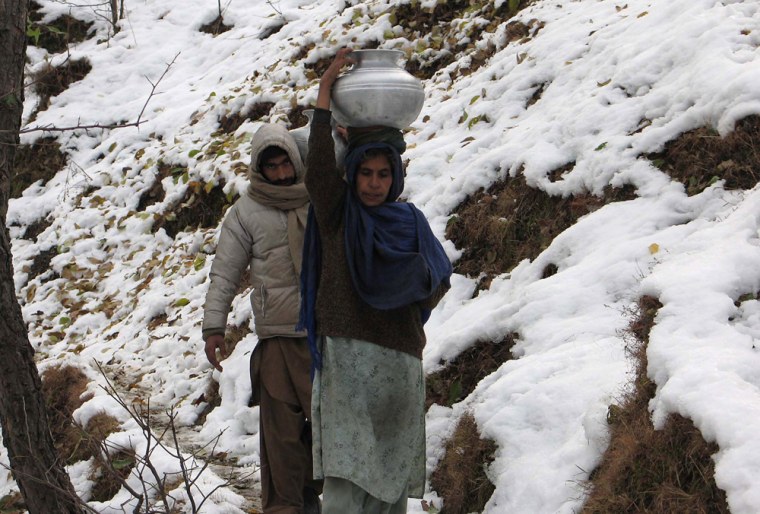Three months after South Asia’s monster earthquake, hundreds of thousands of survivors face a fight to survive the Himalayan winter, huddling in unheated tents and tin shacks near the ruins of their homes.
Health workers expect fatalities from cold-related diseases like pneumonia — anecdotal reports suggest dozens of children already have died — but Pakistani officials say enough shelter and supplies are in place to prevent a “second wave” of deaths on top of the 87,000 killed by the Oct. 8 temblor.
Senior U.N. aid officials are more circumspect, saying nobody can predict the weather’s impact. But they are backing away from dire warnings in the immediate aftermath of the disaster when the world body’s humanitarian chief Jan Egeland said tens of thousands more could die without more aid.
Jan Vandemoortele, the U.N. humanitarian coordinator for Pakistan, said there was now the capacity — dozens of helicopters, scores of clinics and thousands of tons of food stocks — to keep people alive through the crisis, so long as the weather periodically cleared to let aid delivery and medics reach the vulnerable.
“On that basis, we will be able to prevent a second wave (of deaths),” he said.
Weather break helped relief efforts
A mild December allowed more time than expected to rush in aid for more than 3 million left homeless by the magnitude 7.6 quake that reached across a 12,000-square-mile swath of mountains, stretching from northwestern Pakistan eastward into India’s portion of disputed Kashmir, where 1,350 people also died in the quake.
The new year started badly. For three days, driving rains tore through the valleys and up to 4 feet of snow fell on mountain villages, where temperatures dipped to 5 degrees.

“This weather is the nightmare we were expecting,” said Larry Hollingworth, the U.N. deputy humanitarian coordinator. “People are now at their most vulnerable.”
Helicopters were grounded and roads were blocked, virtually halting relief efforts for several days. On mountainsides, hundreds of flimsy tents collapsed under the weight of snow. In the relatively well-supplied lowland camps that house about 250,000 displaced people, rain brought floods that drenched tents.
“We are used to the winter because we live in the mountains but here we have no proper shelter. The children are getting sick,” said Akber Jan, a quake widow who lives with her seven children in a tent at a muddy camp in Muzaffarabad, the capital of Pakistan’s portion of Kashmir.
Survivors on mountaintops were spared the rain, but little else.
At Maidan village, 6,930 feet up in the remote Allai valley, the snow is now knee-deep and residents were starting Friday to slaughter their valuable livestock to supplement food handouts from the U.N. World Food Program.
“We only used to plant maize and there’s not much left. We have yogurt but we are dependent on WFP for other food,” said Saleem Khan, a 32-year-old village elder.
He said that 20 percent of the village’s 5,000 people had moved to the valleys, but the rest planned to tough out the winter as they were afraid of losing livestock and land.
Exposure threatens youngest survivors
Like many villages in the Himalayas, Maidan has no doctor and suffers fatalities from the cold each winter. But Khan said that since the quake, about 30 children had died — far more than usual — because they had been sleeping in the open before their mud and wood homes were rebuilt.
The U.N. estimates that across the quake zone, 400,000 people have opted to stay in villages above 5,000 feet, where the Pakistan army is helping to erect tens of thousands of corrugated iron shelters. At lower elevations about 1.9 million are living in tents.
Pakistan’s federal relief commissioner, Maj. Gen. Farooq Ahmad, was confident that adequate shelter has been provided to prevent major loss of life.
“The risk (of more deaths) would have been there if we had failed to provide this,” he said. “People should be reasonably comfortable.”
‘It may already be too late’
Nongovernment aid groups are less optimistic, saying the quality of preparation for the winter varies widely from well-supplied camps near urban centers to spontaneous settlements that wait for handouts from aid trucks and choppers.
“There are tens of thousands of people without adequate protection,” said Shaheen Chughtai, a spokesman for Oxfam. “We are poised to see a second wave of deaths unless there’s rapid action. For some people, it may already be too late.”
Vandemoortele said that because of a global shortage, few of the hundreds of thousands of tents are fully equipped for winter — when temperatures can drop to below minus 4 degrees in the mountains. The thaw usually comes in March.
But he said that 90 percent of the tents had been customized for the cold and wet — even if it was just with a ground tarpaulin, some plastic sheets slung over the tent and blankets. He said what people need now is more warm clothes and quilts.
A funding shortfall — the U.N. still has only received about half of the money needed to cover its $2 million-a-day expenses until early April — has fueled suspicions that international relief agencies have exaggerated the gravity of the situation to pressure donors for more funds.
On the other hand, strikingly positive assessments from Pakistan’s army, which has deployed about 100,000 soldiers for the relief effort, smack of pride that this Islamic nation of 150 million people is coping well with the disaster.
“Whether the Pakistan government is right in being optimistic, and whether we are right in being pessimistic, I’m not sure,” said the U.N.’s Hollingworth. “But the people I deal with in the field from Pakistan and the humanitarian community are all well aware that we have a real battle ahead of us.”
